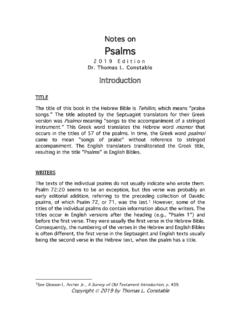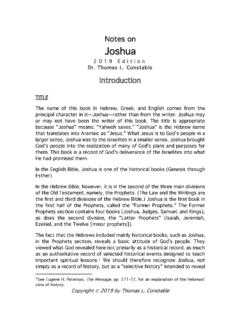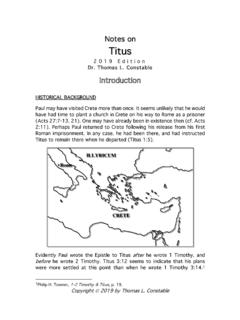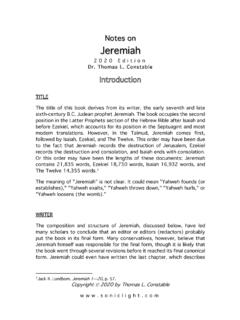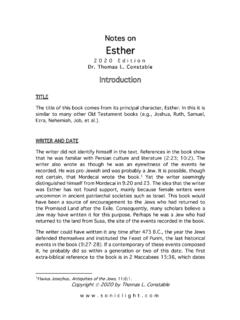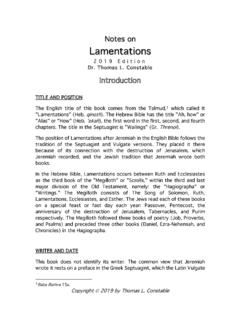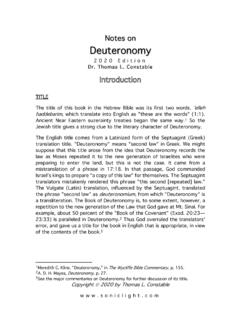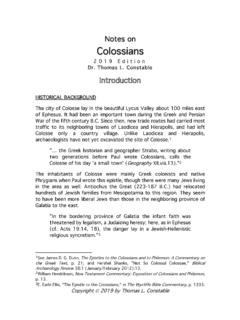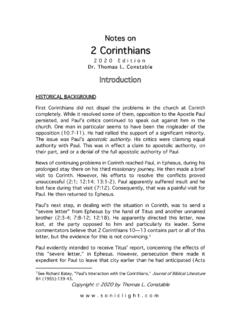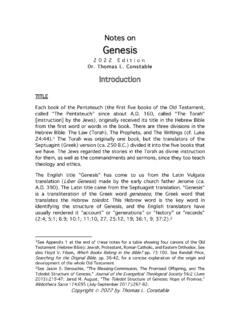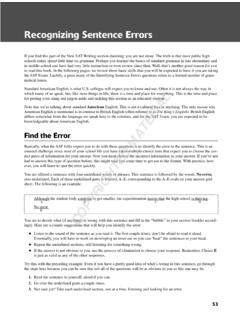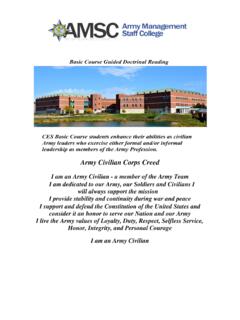Transcription of Notes on 1 John - Plano Bible Chapel
1 Copyright 2021 by Thomas L. Constable Notes on 1 John 2021 Edition Dr. Thomas L. Constable HISTORICAL BACKGROUND This epistle, like Hebrews, does not contain the name of its writer, but from its very early history the church believed the Apostle John wrote it. Several ancient writers referred to this book as John's Though modern critics have challenged this view, they have not destroyed Neither is there any reference to who the first recipients of this epistle were, or where they lived, other than that they were Christians (2:12-14, 21; 5:13). They may have been the leaders of churches (2:20, 27). According to early church tradition, John ministered in Ephesus, the capital of the Roman province of Asia, for many years after he left Palestine. We know from Revelation 2 and 3 that he knew the churches and Christians in that Roman province well.
2 Perhaps his readers lived in that This was probably a letter designed to circulate among several congregations, in contrast to having been intended for only By way of contrast, John's second and third epistles contain the name of the writer, the recipient, and greetings. The false teachers and teachings to which he alluded suggest that John wrote about conditions that existed in Asia: Judaism, Gnosticism, Docetism, the teachings of Cerinthus (a prominent Gnostic), and others. Explanations of these will follow in the exposition. These philosophies extended beyond Asia, but they were present there during John's lifetime. , Irenaeus, Clement of Alexandria, and Tertullian. 2 See Charles C. Ryrie, "The First Epistle of John," in The Wycliffe Bible Commentary, pp. 1464-65, for a concise discussion of views of authorship; and see Henry Alford, The Greek Testament, 4:1:159-65, for a longer discussion.
3 3 Robert W. Yarbrough, 1 3 John, pp. 16-21. See also Alford, 4:1:169. 4 Colin G. Kruse, The Letters of John, pp. 4, 8, 15. 2 Dr. Constable's Notes on 1 John 2021 Edition "The heresy which occasioned 1 and 2 John cannot be parallel with any other manifestation of heresy known from that era. Yet it has affinities with more than one such movement."1 This is one of the most difficult of all the New Testament books to date. One of the few references in the book that may help us date it is 2:19. If John meant that the false teachers had departed from among the apostles, a date in the 60s seems possible. This could place it about 60-65, before the Jewish revolts of 66-70 scattered the Jews from Judea. In this case, John may have written from However, many conservative scholars believe John wrote this epistle much later, between about 85 and 97, when he evidently wrote the Gospel of John (ca.)
4 85-95) and the Book of Revelation (ca. 95-96).3 I prefer a date in the 90s, following the writing of John's Gospel, that 1 John seems to "Indeed the Epistle throughout has the Gospel as its background and is hardly intelligible without it."5 In view of the nature and the conclusion of the Book of Revelation, which seems to be God's final revelatory word to humankind, I think John probably composed his epistles before that book. So a date for 1 John in the early 90s, 90-95, seems most probable to Since John ministered in and around Ephesus later in his life, Ephesus seems to be the most probable place from which he wrote this "The writer of 1 John was thus addressing a community, made up of a number of house-churches in and around Ephesus .., which was split in three ways. It consisted of the following: (a) Johannine Christians who were committed to the apostolic 1 Rudolf Schnachenburg, The Johannine Epistles, p.
5 23. 2 See Zane C. Hodges, "1 John," in The Bible Knowledge Commentary: New Testament, p. 882; idem, The First Epistle of John," in The Grace New Testament Commentary, 2:1192. , B. F. Westcott, The Epistles of St. John, pp. xxx-xxxii; F. F. Bruce, The Epistles of John, p. 31; and Yarbrough, p. 17. 4Cf. Stephen S. Smalley, 1, 2, 3 John, pp. xxii, xxxii; Donald A. Carson and Douglas J. Moo, An Introduction to the New Testament, pp. 676-77; and G. G. Findlay, Fellowship in the Life Eternal, p. 49. 5 David Smith, "The Epistles of St. John," in The Expositor's Greek Testament, 5:154. 6 See Donald Guthrie, New Testament Introduction, 3:205-6. 7 See D. Edmond Hiebert, An Introduction to the New Testament, 3:191-97. 2021 Edition Dr. Constable's Notes on 1 John 3 gospel of Jesus as they had received it; (b) heretically inclined members from a Jewish background; (c) heterodox followers from a Hellenistic (and/or pagan) background.
6 The problems relating to the two 'heretical' groups, (b) and (c), were primarily theological and (by extension) ethical; although related difficulties concerning eschatology and pneumatology may have been present also (see on 2:18 and 4:1 ..).. "To complete the picture, it should be noted that the life of the Johannine community was marked by the presence of a fourth group of people: the secessionists. Whereas the members of the first three groups could be found within John's circle, the anti-Christian secessionists had begun to break away from it. These were heretically inclined adherents of the Johannine community. In some cases they may have been genuine, if uninformed, believers. But in other instances they perhaps never properly belonged to John's church (although they thought they did), because they never really belonged to God (see on 1 John 2:18-19; cf.)
7 Also 2:22-23)."1 CHARACTERISTICS "The Epistle is not a polemic primarily, but a letter for the edification of the readers in the truth and the life in Christ. And yet the errors of the Gnostics are constantly before John's mind."2 "John is contemplative rather than argumentative. He presents truths as they come by intuitive perception rather than by reasoned conclusion. He is mystical rather than logical. He sees the confirmation of truth in one's experience of it rather than in demonstration by argument."3 "John's pen is a surgeon's knife, not a philosopher's quill."4 1 Smalley, p. xxiv. 2A. T. Robertson, Word Pictures in the New Testament, 6:200. Cf. Findlay, pp. 59, 69. 3J. Sidlow Baxter, Explore the Book, 6:321. 4 Ibid., 6:324. 4 Dr. Constable's Notes on 1 John 2021 Edition "St. John has no liking for progress along an unending straight road; he loves a circling flight, like his symbol, the eagle.
8 "1 ".. we should read 1 John, not trying to discern the flow of the argument as we would in a Pauline letter, but rather recognizing that it is, in its structure and rhetorical form, a piece of epideictic rhetoric."2 OUTLINE John's style of writing makes it difficult to outline this book. He flows from one subject to another so smoothly that it is often difficult to see clear breaks in his thought. In contrast, Paul typically identified changes in his subject matter clearly. Consequently, in the outline below, some divisions occur at unusual places in the text: not necessarily chapter divisions or even verse divisions. The following outline reflects the structure of a typical deliberative oration that was common in John's I. Introduction: the purpose of the epistle 1:1-4 II. Living in the light of fellowship with God 1:5 2:11 A.
9 Staying on the path by walking in God's light 1:5 2:2 B. Reaching the goal by knowing the God of light 2:3-11 III. Resisting enemies 2:12-27 A. Appreciating spiritual advances 2:12-14 B. recognizing spiritual adversaries 2:15-27 1. Overcoming the world 2:15-17 2. Resisting the antichrists 2:18-27 IV. Living in anticipation of Christ's judgment seat 2:28 4:19 A. Abiding to face Christ confidently 2:28 B. Learning to recognize God's children 2:29 3:10a 1 Adolf Deissmann, Light from the Ancient East, p. 401. 2 Kruse, p. 31. 3 See Zane C. Hodges, The Epistles of John, pp. 31-33, who followed George A. Kennedy, New Testament Interpretation through Rhetorical Criticism. 2021 Edition Dr. Constable's Notes on 1 John 5 C. Learning to recognize Christian love 3:10b-23 1. What love is not 3:10b-15 2. What love is 3:16-18 3. What love does for believers 3:19-23 D. Learning to recognize the God of love 3:24 4:16 1.
10 God's indwelling affirmed 3:24 2. God's Spirit recognized 4:1-6 3. God's indwelling recognized 4:7-16 E. Having boldness at Christ's judgment seat 4:17-19 V. Learning how to live obediently 4:20 5:17 A. The meaning of brotherly love 4:20 5:3a B. The empowerment of brotherly love 5:3b-15 C. The consequences of brotherly love 5:16-17 VI. Christian certainties 5:18-21 Ron Bigalke saw the structure of 1 John as being chiastic: "A Prologue: Eternal Life (1:1-4) B Three Witnesses (1:5 2:2) (to deny sin is to make God a liar) (walk) C The love of God and the believer (2:3-17) D False christs (2:18-27) E Believer's confidence (2:28 3:10) (do not sin) F Love proves abiding (3:11-18) E' Believer's confidence (3:19-24) (do keep God's commands) D' False prophets (4:1-6) C' The love of God and the believer (4:7-21) 6 Dr. Constable's Notes on 1 John 2021 Edition B' Three Witnesses (5:1-12) (to deny Jesus is to make God a liar) (testimony) A' Epilogue: Eternal life (5:13-21)"1 MESSAGE If I were to boil down the message of this epistle into one sentence, it would be this: "Fellowship with God is the essence of eternal life.
